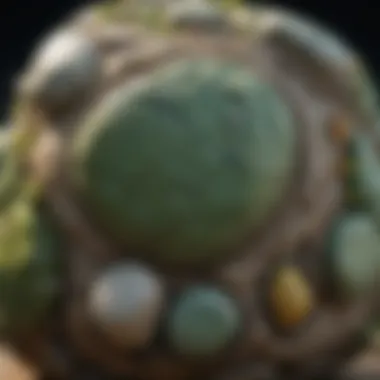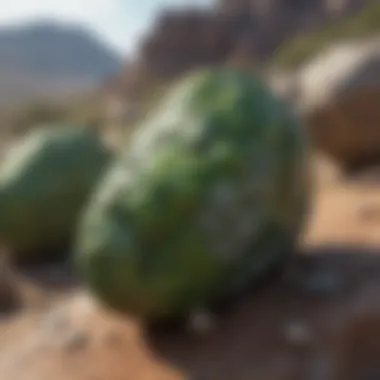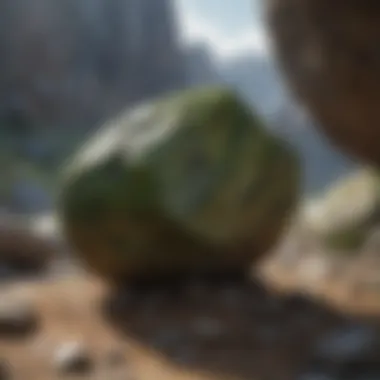Unveiling the Enigma: A Guide to Identifying Green Rocks


Rock and Fossil Identification
Green rocks possess a unique allure that captivates rock and fossil enthusiasts worldwide. The identification process of these verdant specimens involves a meticulous examination of their geological origins and distinguishing characteristics. Understanding the types of rocks and fossils that exhibit green hues is fundamental in unraveling the mystery they hold. Enthusiasts must pay close attention to key attributes such as texture, hardness, color variations, and any embedded fossilized remains that may hint at the rock's history. Advanced tools like handheld magnifiers, UV lights, hardness picks, and streak plates are indispensable aids in the identification process, facilitating a closer inspection of minute details that can reveal the true nature of these captivating green rocks.
Introduction
In the vast world of geology and rock collecting, identifying green rocks stands out as an intriguing and challenging pursuit. This article aims to provide a comprehensive exploration of green rock identification, targeting enthusiasts and collectors seeking to expand their knowledge and appreciation for these unique specimens. By delving into the geological origins and essential characteristics of green rocks, readers will be equipped with the necessary insights to distinguish and appreciate the diversity present in this particular subset of rocks.
Understanding Green Rocks
Defining Green Rocks
Defined by their distinct green coloration, green rocks offer a visually captivating display of nature's geological wonders. The key characteristic that sets green rocks apart is their rich hue, which can range from subtle shades to vibrant tones, hinting at the underlying minerals that contribute to their unique coloration. This definition of green rocks serves as a fundamental building block for the broader discussion on the identification and significance of these specimens within the rock-collecting community.
Significance in Geology
The significance of green rocks in geology extends beyond their aesthetic appeal, playing a crucial role in understanding the earth's geological history and processes. By studying the formation and composition of green rocks, geologists can gain valuable insights into past environmental conditions, mineralogical shifts, and tectonic activities. This aspect underscores the importance of green rocks not just as visually striking collectibles but as valuable resources for geological research and interpretation.
Importance of Identification
Scientific Value
The scientific value of accurately identifying green rocks cannot be overstated. Through precise identification, researchers can unravel complex geological puzzles, trace mineralogical patterns, and contribute to scientific databases for future reference. By delving into the scientific aspects of green rock identification, collectors and researchers alike can foster a deeper appreciation for the earth's intricate processes and material compositions.
Collecting Perspective
From a collecting perspective, the identification of green rocks opens up a world of possibilities for enthusiasts. By honing their skills in recognizing key characteristics, collectors can curate diverse and valuable collections that showcase the beauty and rarity of green rocks. This aspect adds an exciting dimension to the hobby of rock collecting, where each identified specimen becomes a unique piece that contributes to a larger narrative of geological diversity and exploration.
Geological Characteristics
Highlighting the Geological Characteristics within this article allows readers, especially rock and fossil collectors, to grasp the significance of factors such as color variations, textures, and mineral composition when identifying green rocks. Understanding the geological origins of these rocks is fundamental in distinguishing between different types, recognizing their unique traits, and comprehending their environmental significance.
Delving into this aspect provides a foundation for rock enthusiasts to embark on a more informed exploration of green rocks, enabling them to make educated decisions when adding specimens to their collections.
Color Variations


Shades and Tones
The subtle nuances of color variations, specifically shades and tones, within green rocks are a significant aspect explored in this article. Examining these variations not only adds aesthetic value but also serves as a key identifier in rock classification. The spectrum of shades and tones, ranging from deep emerald to mossy green, offers a rich tapestry of color diversity that distinguishes one type of rock from another.
The importance of dissecting these color variations lies in the ability to pinpoint specific mineral compositions present in green rocks. For instance, a darker shade might indicate higher concentrations of certain minerals, while a lighter tone could suggest a different geological history. By honing in on these distinctions, collectors can gain valuable insights into the formation and evolution of green rocks.
Underlying Minerals
Underlying minerals beneath the surface of green rocks offer a fascinating glimpse into their geological story. The presence of distinct minerals mirrors the environmental conditions in which these rocks originated, shedding light on the processes that shaped them over time. Identifying these underlying minerals enhances our comprehension of the rock's structure and properties.
Analyzing the composition of underlying minerals in green rocks contributes to a holistic understanding of their formation. By recognizing the specific minerals interwoven within the rock matrix, enthusiasts can correlate these findings with geographical locations or metamorphic events, unveiling a deeper narrative of these captivating specimens.
Texture and Formation
Smooth vs. Rough Surfaces
The textural aspects, comparing smooth versus rough surfaces of green rocks, hold great significance in discerning their origins and geological evolution. The tactile differences between these surfaces provide valuable clues about the conditions under which these rocks were formed and the forces that shaped them.
Smooth surfaces may indicate processes like erosion or sedimentation, reflecting a history of weathering and deposition. In contrast, rough surfaces could suggest igneous or metamorphic origins, hinting at volcanic activities or tectonic movements that influenced the rock's development. Understanding these textures aids collectors in painting a vivid picture of the rock's journey through time.
Origin and Processes
Exploring the origin and processes involved in the formation of green rocks unravels a captivating narrative of geologic events. Understanding how these rocks came into existence, whether through volcanic eruptions, tectonic activities, or sedimentary deposits, provides valuable context for collectors. By tracing the origin and processes, enthusiasts can appreciate the intricate forces of nature that sculpted these unique formations.
Delving into the geological processes also sheds light on the transformational journey of these rocks, from their initial stages to their present state. By connecting the dots between the origins and processes involved, collectors can gain a deeper appreciation for the intricate network of events that culminated in the creation of green rocks.
Identification Techniques
Identification techniques are crucial in the field of green rock identification, serving as the fundamental process that enables enthusiasts and collectors to discern between different types of rocks accurately. In this article, the focus on identification techniques provides a comprehensive understanding of how visual examination, physical tests, and chemical analysis contribute to the overall identification process. By detailing specific elements such as distinguishing features, patterns, veins, hardness scale, luster evaluation, acid reactions, and mineral composition, readers gain valuable insights into the various methodologies employed to identify green rocks effectively.
Visual Examination
Distinguishing Features
Distinguishing features play a pivotal role in the identification of green rocks, as they act as unique characteristics that differentiate one rock type from another. These features encompass aspects such as color variations, texture differences, and structural patterns that help in categorizing and cataloging rock specimens accurately. By focusing on distinguishing features, this article sheds light on the importance of keen observation and detailed analysis to accurately identify and classify green rocks within the geological spectrum. Understanding the specific attributes that define each rock type enhances the overall identification process and aids collectors and enthusiasts in expanding their knowledge base.


Patterns and Veins
Patterns and veins represent intricate details within green rocks that provide valuable information about their formation and geological history. By examining the patterns and veins present in rock specimens, researchers and collectors can decipher clues about the environmental conditions under which the rocks were formed. This section of the article highlights the significance of patterns and veins in identifying green rocks, emphasizing their role in understanding the intricate processes that shape these natural formations. By delving into the unique patterns and veins found in green rocks, readers gain a deeper appreciation for the diversity and complexity of geological structures.
Physical Tests
Hardness Scale
The hardness scale is a fundamental aspect of physical testing in green rock identification, offering valuable insights into the durability and composition of rock specimens. By assessing the hardness of green rocks using established scales such as Mohs Scale of Hardness, enthusiasts can determine the relative resistance of rocks to scratching and abrasive forces. This section elaborates on the importance of the hardness scale in distinguishing between different rock types based on their physical properties, providing collectors with a systematic approach to assessing the hardness of green rocks accurately.
Luster Evaluation
Luster evaluation plays a crucial role in understanding the surface characteristics and reflective properties of green rocks, contributing to the overall identification process. By examining the luster of rock specimens under various lighting conditions, collectors can gather valuable information about the mineral content and composition of the rocks. This segment of the article emphasizes the significance of luster evaluation in determining the quality and authenticity of green rocks, underscoring its importance in differentiating between similar-looking specimens based on their unique shine and reflective properties.
Chemical Analysis
Acid Reactions
Acid reactions serve as a pivotal method in chemical analysis for green rock identification, allowing collectors to assess the reactivity of rocks to different acidic solutions. By conducting acid tests on rock samples, enthusiasts can determine the mineral composition and chemical makeup of green rocks, aiding in their accurate classification and identification. This portion of the article elaborates on the significance of acid reactions in revealing hidden characteristics of green rocks, providing readers with an in-depth understanding of how chemical analysis contributes to the overall identification process.
Mineral Composition
Mineral composition analysis is a critical aspect of green rock identification, as it entails studying the inherent minerals present in rock specimens to determine their classification and origin. By scrutinizing the mineral composition of green rocks through various analytical techniques, collectors can unveil essential insights into the geological history and formation processes of the rocks. This section of the article emphasizes the importance of mineral composition analysis in enhancing the accuracy and efficiency of green rock identification, offering readers a comprehensive insight into the intricate chemical composition of these fascinating geological specimens.
Common Types of Green Rocks
In the realm of green rock identification, delving into the world of common types holds paramount significance. Understanding the common types of green rocks not only expands our knowledge but also aids in recognizing these geological wonders in various settings. By highlighting the different varieties within this category, enthusiasts can better appreciate the diversity and unique characteristics that define each type.
Jade and Serpentine
Distinctive Features
Exploring the distinctive features of jade and serpentine unveils a world of unique allure and geological importance. Jade, known for its resilience and mesmerizing hues, stands out as a symbol of beauty and strength. Its smooth texture and vibrant shades make it a sought-after choice for jewelry and ornamental purposes. On the other hand, serpentine, with its intricate patterns and earthy tones, captivates collectors and geologists alike. The distinct veining and color variations of serpentine add a touch of mystery to these green rocks, setting them apart in the realm of mineral identification.
Popular Varieties


The popularity of jade and serpentine stems from their versatility and historical significance. Jade, in its various forms such as nephrite and jadeite, represents cultural heritage and spiritual beliefs in different civilizations. The ornamental value of jade has made it a favorite among artisans and collectors throughout history. Similarly, serpentine's widespread occurrence and diverse color spectrum appeal to both amateur geologists and seasoned collectors. Its array of popular varieties, ranging from antigorite to lizardite, showcase the intricate beauty and geological complexity of these green rocks, making them prized possessions in any collection.
Malachite and Chlorite
Characteristics and Uses
The distinctive characteristics and practical uses of malachite and chlorite elevate them to the forefront of green rock identification. Malachite, with its striking green bands and vibrant coloration, has been cherished for centuries as a decorative stone and pigment source. The unique banding patterns of malachite add a touch of elegance to jewelry and art pieces, attracting both collectors and designers. Chlorite, on the other hand, boasts a subtle green hue and a silky luster, making it a popular choice for carvings and architectural ornamentation. The versatile nature of chlorite, with its abundance in metamorphic rocks, renders it indispensable in both geological studies and lapidary arts.
Identification Tips
Understanding the key identification tips for malachite and chlorite enhances the appreciation and recognition of these green minerals. For malachite, focusing on its distinct banding patterns and effervescent reaction to acids aids in pinpointing this mineral in various specimens. Knowing the unique crystal habits and cleavage planes of malachite simplifies its differentiation from other green minerals. Similarly, recognizing the foliated structure and platy nature of chlorite assists in distinguishing it from similar-looking rocks. By honing these identification skills and paying attention to specific features, rock and fossil collectors can build a comprehensive understanding of malachite and chlorite within the context of green rock identification.
Practical Tips for Collectors
In the expansive world of rock and fossil collection, practical tips are like hidden gems, essential for enthusiasts to navigate and thrive in their pursuit of uncovering the mysteries of green rocks. These tips serve as guiding beacons, illuminating the path towards successful identification, preservation, and display of these unique specimens. By focusing on specific elements such as field identification, storage techniques, and showcasing strategies, collectors can elevate their knowledge and experience to new heights.
Field Identification
Locations and Occurrences
Exploring the diverse tapestry of locations and occurrences where green rocks can be found is a pivotal aspect of field identification. From ancient geological formations to remote mines and quarries, each location holds clues to the rocks' origins and compositions. Understanding the specific characteristics of these sites and their geological significance enhances collectors' ability to identify and appreciate green rocks. Whether it's the verdant hills of a certain region or the rocky outcrops of a particular mountain range, each location adds a layer of intrigue and context to the specimens collected. Collectors can benefit greatly from studying the unique features of different locations, enabling them to expand their collection with a diverse array of green rocks.
Tools and Equipment
Equipping oneself with the right tools and equipment is paramount in the field of rock and fossil collection, especially when it comes to the meticulous task of identifying and cataloging green rocks. Tools such as geology hammers, chisels, and magnifying glasses aid in the precise extraction and examination of specimens, allowing collectors to uncover intricate details and patterns hidden within the rocks. Advanced equipment like UV lights and hardness testing tools further assist collectors in identifying the mineral composition and authenticity of green rocks. Understanding the functionalities and applications of these tools empowers collectors to engage more deeply with their collection, making informed decisions and discoveries along the way.
Preservation and Display
Storage Techniques
Preserving the beauty and integrity of green rocks requires careful consideration of storage techniques, ensuring that these precious specimens remain pristine for years to come. Proper storage techniques, such as using acid-free paper, cloth bags, or display cases, shield the rocks from environmental factors that could cause deterioration or discoloration. By leveraging these techniques, collectors can safeguard their collection against moisture, sunlight, and other damaging elements, maintaining the rocks' visual appeal and scientific value. Implementing strategic storage solutions also allows for efficient organization and cataloging, enabling collectors to easily access and showcase their prized green rocks.
Showcasing Strategies
Displaying green rocks offers collectors the opportunity to share the beauty and allure of these natural wonders with others, driving a deeper appreciation for the world of geology and mineralogy. Showcasing strategies play a vital role in presenting green rocks in their best light, whether through thematic arrangements, informational labels, or interactive exhibits. By curating exhibitions that highlight the diversity and significance of green rocks, collectors can spark curiosity and interest among viewers, fostering a sense of wonder and discovery. Embracing innovative showcasing strategies not only enriches the collector's experience but also inspires others to explore the enchanting realm of green rocks.







